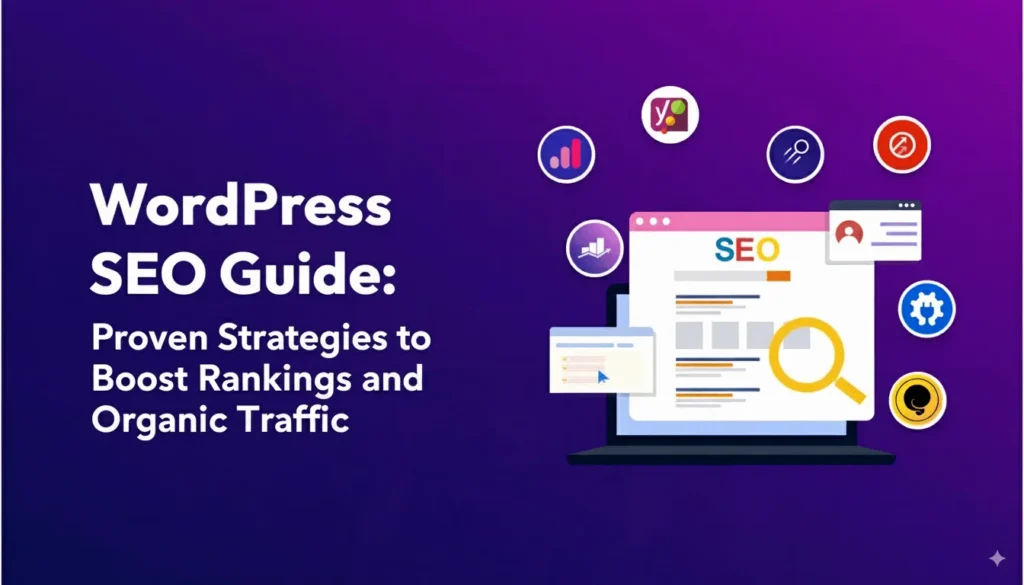Search Engine Optimization (SEO) is the backbone of any successful website. Without it, even the most beautiful WordPress site may struggle to appear on Google, Bing, or Yahoo. SEO is the ongoing process of improving your website’s visibility and ranking in Search Engine Results Pages (SERPs).
In this guide, we’ll cover the best WordPress SEO techniques and plugins to help you improve search rankings, attract organic traffic, and grow your brand online.
Why WordPress SEO Matters
A well-optimized WordPress website can deliver:
✅ Higher search engine rankings and online visibility
✅ Increased organic traffic without paid ads
✅ Improved brand trust and authority
✅ Cost-effective long-term marketing results
✅ Better user experience and engagement
✅ Measurable SEO performance with analytics
Top WordPress SEO Techniques for Higher Rankings
1. Check WordPress Visibility Settings
Sometimes, websites remain hidden from search engines due to incorrect settings.
How to Fix It:
- Go to WordPress Dashboard → Settings → Reading
- Make sure “Discourage search engines from indexing this site” is unchecked.
If this box is checked, Google and Bing won’t index your site—making all your SEO efforts useless.
2. Set Your Preferred Domain (www vs non-www)
Google treats domain.com and www.domain.com as separate sites. Setting a preferred domain ensures consistency.
Steps:
- Dashboard → Settings → General
- Update both WordPress Address (URL) and Site Address (URL) with your chosen version.
3. Optimize Your Permalink Structure
A clean permalink (URL) improves SEO and encourages more clicks.
Best Practice:
- Dashboard → Settings → Permalinks → Select Post Name
- Example:
yoursite.com/wordpress-seo-tipsinstead ofyoursite.com/?p=123
4. Use Categories and Tags Effectively
Organized content helps search engines understand your site structure.
- Categories: Broad topics (e.g., SEO, WordPress, Plugins)
- Tags: Specific keywords related to a post (e.g., Keyword Research, Yoast SEO, Meta Descriptions)
Both improve internal linking and enhance user navigation.
5. Enable Manual Comment Approval
Spammy comments often include harmful backlinks that hurt SEO.
Steps:
- Dashboard → Settings → Discussion
- Check “Comment must be manually approved”
This protects your site’s credibility and ranking.
6. Install a WordPress SEO Plugin
SEO plugins simplify optimization tasks like meta tags, sitemaps, and content analysis.
Popular Options:
- Yoast SEO – real-time content analysis
- Rank Math SEO – keyword optimization, schema markup
- All in One SEO (AIOSEO) – XML sitemap, WooCommerce SEO
- SEOPress – titles, meta descriptions, social media tags
- The SEO Framework – lightweight, fast optimization
- Site Kit by Google – integrates Analytics, Search Console & PageSpeed Insights
7. Create and Submit an XML Sitemap
An XML sitemap helps Google quickly crawl and index your site.
Plugins like Yoast SEO or Rank Math automatically generate sitemaps.
Submit your sitemap in Google Search Console for faster indexing.
8. Strengthen Internal Linking
Internal links connect related content, improving navigation and SEO authority.
Example: A blog on “WordPress SEO Tips” should link to another on “Best SEO Plugins for WordPress.”
9. Optimize Images for SEO
Image optimization improves site speed and rankings.
Best Practices:
- Use JPEG or WebP for faster loading
- Compress images with tools like TinyPNG or ShortPixel
- Always add alt text with keywords (e.g., “WordPress SEO settings screenshot”)
- Resize images to match display dimensions
10. Secure Your Website with SSL (HTTPS)
Google favors secure websites with HTTPS.
Steps:
- Install an SSL certificate (often free with hosting providers)
- Enable HTTPS in WordPress Settings
A secure site builds trust with users and improves SEO ranking.
Must-Have WordPress SEO Plugins
- Yoast SEO – Best for beginners, easy to use
- Rank Math SEO – Advanced features for professionals
- All in One SEO (AIOSEO) – Great for WooCommerce SEO
- The SEO Framework – Lightweight and fast performance
- SEOPress – Full-featured, affordable alternative
- Site Kit by Google – Direct integration with Google tools
Final Thoughts
Implementing these WordPress SEO techniques and using the right plugins will significantly improve your website’s visibility, organic traffic, and user experience.
Remember, SEO is not a one-time task but a continuous strategy. Stay consistent, monitor your analytics, and refine your approach to keep climbing the search rankings.
By following this guide, you’ll be on your way to making your WordPress website rank higher on Google and attracting the audience your business deserves.


